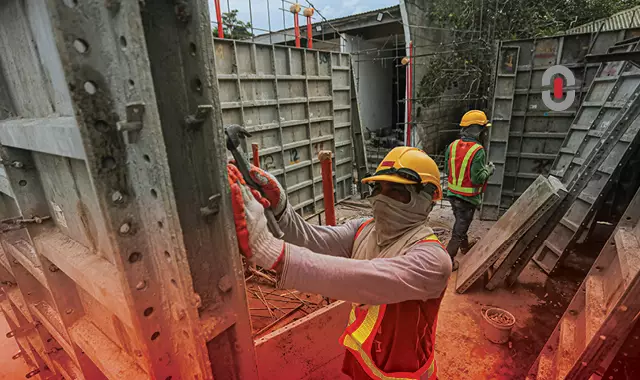International projects are becoming increasingly common in the construction industry as the demand for international professionals on high-scale construction projects grows. Huge international construction projects bring together professionals from different cultures and languages, and the need for accurate translation is becoming a necessity for the successful completion of the projects. Accurate translation services are crucial for ensuring clear communication, and maintaining a safe and efficient working environment. In this article, we’ll explore the vital role of translation in international construction projects, focusing….
The Role of Translation in facilitating clear communication
Accurate and clear translation is essential for bridging communication gaps between multinational teams in the construction industry. It ensures that all team members, regardless of their native language, have a precise understanding of project plans, safety protocols, and design specifications. This uniform comprehension is crucial for coordinating efforts, minimizing errors, and maintaining a cohesive workflow. When translations are accurate and clear, misunderstandings are significantly reduced, allowing for smooth collaboration and efficient project execution. In this way, translation acts as a vital conduit for information, ensuring that all team members are aligned with the project’s objectives and safety requirements, ultimately contributing to the overall success and safety of international construction projects.
Accurate translation is essential for bridging communication gaps between international teams in large construction projects. Clear translation ensures that all employees have a precise understanding of the project plans, safety protocols, and design specifications. Understanding the project at hand well is crucial for coordinating efforts, minimizing potentially dangerous errors, and maintaining an overall cohesive workflow.
Accurate Translation can ensure project success
Precision in Technical Documents
Precise translation of technical documents is crucial in the construction industry. Construction projects use various types of documents with distinct technical specifications, blueprints and contracts that detail the aspects of work to be done. Most of the time these documents contain specific terms that need careful attention from an experienced translator. Accurate translation eliminates ambiguities and discrepancies that could lead to misunderstandings and errors during construction.
Translation errors can have a negative effect on project timelines and costs. They can lead to the use of incorrect materials or construction methods, leading to delays and rework, thus increasing the overall costs. Errors in contract translation can lead to legal disputes, and even halting the progress of the construction project. Mistakes in blueprints can lead to structural errors, endangering the safety of the project and necessitating expensive and time-consuming corrections. Therefore investing in a professional translation service can maintain the project integrity and save costs.
Effective Stakeholder Communication
Communication with stakeholders is another critical aspect of ensuring project success, and professional translation plays a key role in this process. Stakeholders, such as investors, regulatory bodies, and community representatives, require regular updates to stay informed about the project’s progress and any ongoing issues. Translating these reports accurately ensures that the stakeholders will receive clear and comprehensive information. This will boost the trust and confidence among stakeholders as they will feel fully informed and that their interests are being considered.
Professional translation can help with smooth stakeholder relations by ensuring that all communications are accessible and understandable. Accurately translated project progress reports can help investors monitor their investments and make informed decisions. Furthermore translation of regulatory documents ensures that compliance requirements are met, preventing legal issues and project delays. Professional translation can help maintain positive relationships with the stakeholders by preventing misunderstandings and helping with the smooth execution of construction projects.
Software Localization: The Role of Translation and Localization in Construction Software
Software localization is another critical part of construction industry translation for ensuring that digital tools and platforms are usable and accessible by international workers. Translation and localization of construction software involve adapting the interfaces, commands, and user manuals to accommodate the different languages used on the project. The process goes beyond simply converting the text from one language to another, it requires a nuanced approach that considers local measurements units, date formats, technical terminology and even local idioms. Software localization can make it easier for team members to navigate the software, understand instructions, and perform their tasks efficiently.
Localized construction software helps bridge communication gaps and enhances collaboration among multinational teams. Accurately translated software allows all team members to operate the software with confidence, reducing the likelihood of errors and misunderstandings. For example, a project management tool with a localized interface allows all team members to input and retrieve information in their native language, ensuring that everyone is on the same page. Similarly, design applications with translated technical terms and commands help engineers and architects avoid misinterpretations that could compromise the integrity of their work.
Beyond Contracts: The Broad Scope of Translation in Construction
Translation in the construction industry extends beyond contracts and software. Translating contracts are crucial in the industry, however the scope of translation in construction also encompasses a wide array of technical documents essential for the proper project execution. Such documents include technical manuals, architectural drawings, construction plans and other.
Technical manuals are resources that provide detailed instructions on operating machinery, understanding technical specifications, and adhering to safety protocols. Accurate translation of the manuals is vital for ensuring that everyone working on the project can understand and follow the procedures correctly. This not only enhances operational efficiency but also reduces the risk of accidents and equipment malfunctions, thereby assisting with a safer work environment.
Architectural drawings and construction plans outline the project details – from structural elements to electrical layouts. Translating these documents ensures that all team members, including architects, engineers and construction workers, have a consistent understanding of the project’s design and specifications. Clear and accurate translations prevent misinterpretation that could lead to serious construction errors, costly rework and delays. Moreover, they facilitate better coordination among international teams, as everyone can refer to the same accurately translated documents, fostering a unified approach to project execution.
Translation also plays a critical role in training and development materials. Construction projects often involve training sessions for workers to familiarize them with the project, new techniques, technologies and safety practices. Translating these training materials ensures that all team members understand their content fully, leading to more effective outcomes and better implementation of the practices on the construction site.
Safety First: The Crucial Role of Translation in Ensuring Worker Safety
 Worker safety is paramount in any industry and construction is no exception. Translation plays a critical role in ensuring that safety protocols and signage are understood by all workers regardless of their native language. On an international construction site, accurately translated safety information is essential to minimize the risk of accidents.
Worker safety is paramount in any industry and construction is no exception. Translation plays a critical role in ensuring that safety protocols and signage are understood by all workers regardless of their native language. On an international construction site, accurately translated safety information is essential to minimize the risk of accidents.
Accurately translated safety protocols provide clear instructions on how to perform tasks safely, handle equipment properly, and respond to emergencies. When these protocols are available in several languages, all workers can understand the specific steps they need to take to protect themselves and their colleagues. This is especially true for procedures that involve hazardous materials or heavy machinery, where a small misinterpretation can lead to severe injuries and even fatalities. Ensuring that all safety guidelines are comprehensible to every team member, translation helps create a safer work environment where everyone is aware of the risks.
Another critical component of a safe construction site is the safety signage. Signs indicating hazardous areas, mandatory protective gear and emergency exits must be instantly recognizable and easily understood by all workers. Multilingual signs ensure that the messages are communicated effectively. For example, a sign warning about electrical hazards needs to be immediately clear to avoid accidental contact, which could result in electrocution. By providing translated safety signs, construction companies can significantly reduce the likelihood of accidents and ensure that all workers can navigate the site safely.
Conclusion
As international projects become more common in the construction industry, accurate translation is essential for success. Successful translation ensures that all team members understand the project plans, safety protocols, and design specifications. Translation of technical manuals, architectural drawings, and construction plans prevents costly errors and delays. Software localization makes digital tools accessible and user-friendly for international teams, enhancing their collaboration and efficiency. Furthermore, translated safety protocols and signage protect workers by minimizing risks and preventing accidents. In conclusion, investing in professional translation services is crucial for project success and a safe work environment in the global construction industry.
